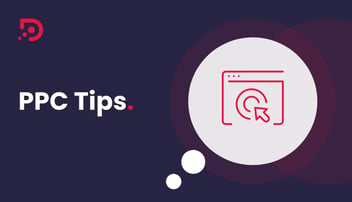In this blog, we're going to take a look at choosing the right paid advertising channel for your business.
This blog is designed as an accompaniment to our PPC training videos, but can also be read as a stand-alone blog.
Watch our PPC video here:
How to Choose the Right PPC Advertising Channel
For the purposes of this blog, we are going to assume that it is widely known that Google Ads is the most popular PPC channel. It is the 'go to' online advertising channel, and rightly so, as Google is most likely the place where you're going to make the most of your revenue and generate most of your traffic.
Therefore, for the sake of this video, we're going to take a look at some of the other paid advertising opportunities that you have across the digital sphere as a business, when you're promoting a new client launch, a new campaign, whatever it may be.
We'll look at some of the key objectives of each channel and depending on what we want to achieve, we'll then decide what channel we go forward with.
Explaining the Different Types of PPC Ad Formats
Just as a broad explanation of these channels, looking at search ads, the core of that advertising format is for high conversion rates and to generate revenue and return on investment. There shouldn't really be any other goal on this channel, as it is people searching for your business, product or service with intent on buying.
Moving on to display ads, these are not purely text ads but also contain imagery and video. Therefore, we can get creative and highly visual with these. The objective of this format is to drive more brand awareness. It's also to drive high levels of traffic to your website, which can in turn increase your conversion rate optimisation efforts across your website. It can increase deals organically as well, due to your user experience optimisation from the influx in traffic.
Then moving to social ads, with these you can become a thought leader in the industry. With social ads, we mainly focus on LinkedIn, as that channel is a very renowned business-to-business platform. This is where people are going to be looking to read your white papers or download your pieces of content and connect with industry decision-makers.
Focussing on LinkedIn Ads
So moving forward, we'll look at LinkedIn ads as a channel. Its targeting criteria are really what makes this channel very special. There are some options here based on company targeting. You can target on company growth rate or you can target on industry, company name, revenue and company size. For any business, it is very powerful to be able to target this type of criteria, especially in a B2B world.
You can also target individuals by their job title. You can target on their level of experience, which is vitally important in the sense that by targeting their level of experience you could exclude who you don't want - i.e. you could exclude, say, students or executives.
Basically, you can exclude people who are not likely to be making any kind of business decision and whose engagement with your ads may only be for research purposes. So by excluding those people, your ads are now being shown to people who are actual decision-makers.
Therefore, their engagement with your ads is at a level where they may convert and potentially convert into customers on the back end too. Now, one point with LinkedIn is that in our experience, it is very expensive and you may find that the lead quality will not be as good as on search ads.
Moving on to Microsoft Advertising
As an alternative moving forward, we would recommend Microsoft advertising. It basically mirrors your Google Ads and your search ads. You can actually import your entire campaigns straight from Google Ads to Microsoft Advertising and you don't really need to make any other adjustments once your ads go live.
However, Microsoft acquired LinkedIn a few years back and they added their targeting criteria as optimisation points on Microsoft Advertising. It is not like LinkedIn Ads where you can choose list of targeting criteria, but what you can do is bid on these targeting criteria. So when setting up your campaign, if you add target categories, you can go into, for example, 'job function'.
If your goal is to target a person who has a particular job function, then you can add this to your targeting criteria and you can bid higher on this optimisation point. As you optimise these types of criteria you will both increase your lead quality and increase your conversion rates, both leading to higher amounts of revenue in the back end.
Microsoft advertising also offers a lower cost per click (CPCs) than Google ads. Therefore it has a lower barrier but it does also have lower volume in terms of keywords and search queries. So it's really about finding that balance, and it is highly advised to run both Google Ads and Microsoft Advertising together.
Trying out Facebook Ads
Moving on to the Meta-verse, it was only recently, in August of this year, that Facebook moved into the B2B advertising sphere. Now you're able to target business decision-makers and other B2B audiences across a wide range of sectors within Facebook Ads.
Beforehand it was very difficult for B2B businesses to make the most of Facebook Ads, but now we can actually target these audiences. Another selling point for Facebook's Meta-sphere is its highly powerful retargeting options.
So in conclusion, what we advise you as a business is to use all of these online advertising channels, if your budget allows it. What really brings it all together and what really drives home your return on investment and increases your revenue is your retargeting strategy.
Making the Most of Retargeting
Now, bringing all of this together on your website, you'll need to be setting up audiences for specific pages. You'll use a funnel-based strategy for your audiences. All website users will filter down into certain pages of your website, which will filter down to people who have taken certain actions on your website.
They'll watch a video, click on a certain CTA, and download a white paper, which will in the end filter them right down to the very bottom of the funnel. People who you are delivering highly visual, highly targeted content to - for example at the top level for your website visitors - you'll then just go onto retargeting with more information, more white papers etc.
As you go down each webpage you will deliver content just on that webpage, based on what they interacted with. At the very bottom of the funnel, you will be retargeting them with a very specific message and a very, very specific CTA. Because these are the people who will be there, ready to convert.
This blog and video is a broad overview of which paid ad channels to use. However, please check out our Digital Media Stream YouTube channel and our website for PPC tips on how to set these channels up, how to create audiences and how to set up and optimise your ad campaigns.
Still looking for more PPC insights for your Tech or SaaS company? We’ve got you covered. Find out more through one of the article below:
- Understanding SaaS PPC Agencies
- SEO Versus PPC: The Key Differences and Benefits
- Choosing the Right Keywords for B2B Search Ads
- What can a HubSpot PPC Agency do for you?
- How to Create a Google Ads Audience in HubSpot
- Understanding Google Ads Cost and ROI with HubSpot
- Why PPC Training Makes Sense for Marketing Managers
- 5 PPC Trends you Need to use in your 2023 Strategy
- 5 Pay Per Click Tips for an Experienced PPC Manager
- Power Up your PPC with Performance Max
- Cookieless Advertising: What you Need to Know as a B2B Company
Or, why not check out our PPC Toolkit for SaaS & Technology Companies.





